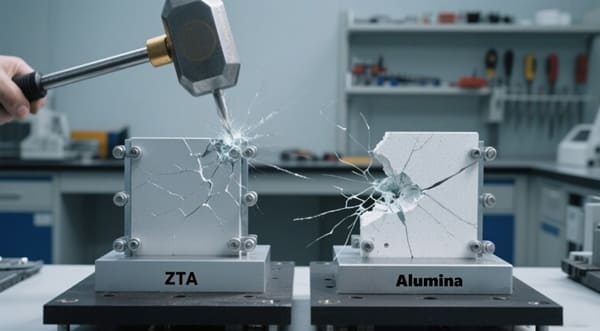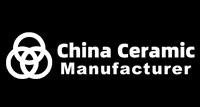ZTA Vs. Alumina: Strength, Toughness, and Performance Compared
In engineering applications—from aerospace to semiconductors—ceramic materials are chosen for their hardness, wear resistance, and thermal stability. However, not all ceramics are created equal. Alumina (Al₂O₃) has long been a standard material due to its excellent hardness and cost-efficiency. Zirconia Toughened Alumina (ZTA), on the other hand, enhances fracture toughness by integrating zirconia particles. This article provides a comprehensive comparison between the two, helping engineers, researchers, and buyers make informed material choices.
At China Ceramic Manufacturer, we specialize in high-quality zirconia toughened alumina and alumina, ensuring optimal performance for industrial and scientific applications.

What Are ZTA and Alumina?
Understanding the composition and structure of each material is critical before evaluating performance. While alumina is a monolithic ceramic known for its high hardness, ZTA is a composite that combines the advantages of both alumina and zirconia.
Material Composition Overview:
| Material | Main Components | Structure Type | Strength Feature | Common Uses |
| ZTA | Al₂O₃ + ZrO₂ | Composite | High toughness + strength | Aerospace, armor, sensors |
| Alumina | Al₂O₃ | Monolithic | High hardness, brittle | Insulators, valves, optics |
What Are the Mechanical Differences Between ZTA and Alumina Ceramics?
Mechanical strength, fracture toughness, and hardness determine how a ceramic will perform under physical loads. ZTA excels in toughness due to zirconia’s stress-induced transformation, while alumina holds the edge in hardness.
Mechanical Properties Comparison:
| Property | ZTA | Alumina |
| Flexural Strength (MPa) | 600–800 | 300–400 |
| Fracture Toughness (MPa·m¹⁄²) | 6–8 | 3–4 |
| Vickers Hardness (Hv) | 1600 | 1800 |
| Wear Resistance | High | Moderate |
ZTA demonstrates significantly better flexural strength and fracture toughness compared to alumina, making it more reliable under mechanical stress or impact. While alumina remains harder, its brittleness limits its performance in dynamic or high-load environments. ZTA bridges that gap with a more balanced mechanical profile suited for demanding applications.
Explore our high-quality zirconia toughened alumina and alumina.
What About Thermal and Electrical Behavior?
Thermal and electrical characteristics are essential for applications exposed to heat, temperature cycling, or current flow. ZTA shows better thermal shock resistance, while alumina is a superior insulator.
Thermal & Electrical Property Comparison:
| Property | ZTA | Alumina |
| Thermal Conductivity (W/m·K) | 8–10 | 25–30 |
| Coefficient of Thermal Expansion (×10⁻⁶/K) | 9.5 | 8.0 |
| Max Operating Temperature (°C) | ~1650 | ~1500 |
| Electrical Resistivity (Ω·cm) | ~10¹⁴ | >10¹⁴ |
| Thermal Shock Resistance | Excellent | Moderate |
ZTA’s superior thermal shock resistance allows it to better withstand rapid heating and cooling cycles without cracking. Although alumina offers higher thermal conductivity and slightly better electrical insulation, ZTA’s balance of properties makes it more reliable in applications where both thermal and mechanical stresses occur simultaneously.
How Are ZTA and Alumina Fabricated?
The fabrication processes for Zirconia Toughened Alumina (ZTA) and Alumina ceramics share many similarities but differ in raw materials and specific parameters to achieve their distinct properties. Both require careful control during each manufacturing step to ensure high density, uniform microstructure, and minimal defects, which directly impact the final performance of the ceramic parts.
ZTA and Alumina Fabrication Process Steps:
- Powder Preparation: Al₂O₃/ZrO₂ mixing (ZTA); pure Al₂O₃ (Alumina)
- Forming: Pressing, slip casting, or injection molding
- Sintering: Pressureless sintering or hot isostatic pressing
- Finishing: Diamond machining, grinding, and polishing
Each step is optimized to maintain material integrity and produce components that meet the demanding standards of aerospace and industrial applications.
Which Performs Better in Aerospace Environments?
Aerospace applications demand materials that can withstand harsh conditions such as extreme thermal shocks, repeated mechanical fatigue, oxidation, and constant vibration. ZTA’s unique combination of enhanced toughness and chemical stability makes it more reliable in these challenging environments compared to alumina.
ZTA vs Alumina in Aerospace Conditions
| Condition Type | Performance Need | ZTA | Alumina |
| Thermal Shock | No cracking after ΔT > 400°C | ✅ Excellent | ⚠️ Moderate |
| Cyclic Fatigue | ≥10⁶ cycles | ✅ High resistance | ⚠️ Prone to cracks |
| Oxidation/Corrosion | High-temp stability | ✅ Chemically stable | ✅ Stable |
| Structural Vibration | No microcracking | ✅ Maintains integrity | ⚠️ Can fail under stress |
This comparison shows that ZTA offers superior durability and reliability in aerospace conditions, making it a preferred choice for critical structural and thermal components.
Where Are ZTA and Alumina Used?
Understanding the distinct applications of Zirconia Toughened Alumina (ZTA) and Alumina reveals how their unique properties meet different aerospace and industrial demands. ZTA’s enhanced toughness and thermal stability make it the preferred choice in critical components where reliability under stress is vital, while alumina remains widely used for electrical insulation and less demanding structural parts.
Applications of Zirconia Toughened Alumina (ZTA):
- Jet engine combustor liners
- Sensor housings for high-temperature and vibration environments
- Thermal barrier coating substrates
- Satellite structural fasteners
- Rocket nozzle liners
Applications of Alumina:
- Electronic insulators and substrates
- Substrate boards for circuit components
- Furnace tubes and high-temperature insulation
- Ceramic valves and seals
- Optical windows and laser components
This comparison highlights how ZTA is often selected for demanding aerospace uses, whereas alumina supports a broader range of general industrial and electronic applications.
Request a custom quote for high-quality zirconia toughened alumina and alumina.
How Do ZTA and Alumina Ceramics Compare in Cost and Efficiency?
When choosing between ZTA and alumina, it’s important to consider not just initial material cost but also long-term efficiency. While ZTA has a higher upfront price and machining complexity, its longer lifecycle and lower maintenance needs often result in better overall value for aerospace applications.
| Factor | ZTA | Alumina |
| Raw Material Cost | Higher | Lower |
| Machining Difficulty | High | Moderate |
| Lifecycle (aerospace) | Longer | Shorter |
| Maintenance Needs | Low | Moderate |
| Total Cost of Ownership | Moderate | Low |
Overall, ZTA’s durability and performance can reduce replacement frequency and maintenance costs, making it a cost-effective option despite the higher initial investment.
Challenges of Using ZTA and Alumina in Industrial Applications
Both ZTA and alumina have strengths but also face specific challenges that can impact their use in aerospace and other demanding applications.
Limitations Overview
Zirconia Toughened Alumina (ZTA):
- Higher material and manufacturing costs
- Requires precise control of zirconia particle dispersion
- More complex and costly to machine
Alumina:
- Brittle and prone to cracking under mechanical stress
- Limited resistance to thermal shock
- Unsuitable for applications involving high dynamic loads or vibration
Understanding these limitations helps engineers select the right material based on performance needs and cost considerations.
Which Ceramic Should You Choose?
Choosing the right ceramic material depends on your specific performance requirements and budget. Use the following guide to help decide between Zirconia Toughened Alumina (ZTA) and Alumina:
Consider ZTA if your application requires:
- Withstanding high mechanical stress, impact, or vibration
- Enduring rapid and repeated thermal cycling
- Use in aerospace, defense, or critical wear-resistant parts
Consider Alumina if your application involves:
- Budget-sensitive designs with cost constraints
- Excellent electrical insulation at moderate temperatures
- General-purpose ceramic components or electronics
This checklist will help you balance performance needs and cost efficiency for your project.
FAQ
| Question | Answer |
| Is ZTA harder than alumina? | No, alumina is harder; ZTA is tougher. |
| Can ZTA handle thermal shock better? | Yes, due to zirconia’s transformation toughening. |
| Which is more cost-effective? | Alumina initially, but ZTA lasts longer. |
| Is ZTA used in electronics? | Yes, in high-temp and structural sensor parts. |
| Can ZTA be 3D printed? | Emerging techniques allow limited ZTA 3D printing. |
Conclusion
Zirconia Toughened Alumina effectively balances the extreme hardness of alumina and the high fracture toughness of zirconia. It’s engineered for environments that demand both strength and reliability, especially in aerospace, automotive, and high-temperature industries. While alumina remains the go-to material for cost-sensitive or electrically insulating applications, ZTA is the superior choice where durability and performance under stress are non-negotiable.
China Ceramic Manufacturer provides high-performance ZTA and alumina ceramics to meet diverse industrial needs, with custom sizes, shapes, and formulations available on request.
Looking for high-quality zirconia toughened alumina or alumina? Contact us today!
